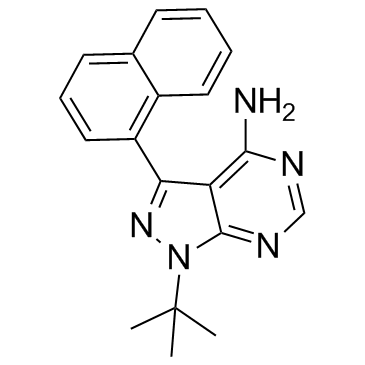1-Naphthyl PP1
Modify Date: 2025-08-20 19:02:39

1-Naphthyl PP1 structure
|
Common Name | 1-Naphthyl PP1 | ||
|---|---|---|---|---|
| CAS Number | 221243-82-9 | Molecular Weight | 317.388 | |
| Density | 1.3±0.1 g/cm3 | Boiling Point | 527.8±45.0 °C at 760 mmHg | |
| Molecular Formula | C19H19N5 | Melting Point | 219-222ºC | |
| MSDS | N/A | Flash Point | 273.0±28.7 °C | |
Use of 1-Naphthyl PP11-Naphthyl PP1(1-NA-PP 1) is a selective inhibitor of src family kinases v-Src and c-Fyn as well as the tyrosine kinase c-Abl (IC50 values are 1.0, 0.6, 0.6, 18 and 22 μM for v-Src, c-Fyn, c-Abl, CDK2 and CAMK II respectively).IC50 Value:1.0 uM (v-Src); 0.6 uM (c-Fyn); 18 uM (c-Abl) [1]Target: Src Family kinase1-NA-PP1 was considerably more potent and showed distinct substituent effects at the pyrazolopyrimidine core. 1-NA-PP1 was cell-active, and potently blocked prostate cancer cell proliferation by inducing G2/M arrest. Overexpression of PKD1 or PKD3 almost completely reversed the growth arrest and the inhibition of tumor cell invasion caused by 1-NA-PP1, indicating that its anti-proliferative and anti-invasive activities were mediated through the inhibition of PKD. Interestingly, a 12-fold increase in sensitivity to 1-NA-PP1 could be achieved by engineering a gatekeeper mutation in the active site of PKD1, suggesting that 1-NA-PP1 could be paired with the analog-sensitive PKD1(M659G) for dissecting PKD-specific functions and signaling pathways in various biological systems [2]. |
| Name | 1-na-pp1 |
|---|---|
| Synonym | More Synonyms |
| Description | 1-Naphthyl PP1(1-NA-PP 1) is a selective inhibitor of src family kinases v-Src and c-Fyn as well as the tyrosine kinase c-Abl (IC50 values are 1.0, 0.6, 0.6, 18 and 22 μM for v-Src, c-Fyn, c-Abl, CDK2 and CAMK II respectively).IC50 Value:1.0 uM (v-Src); 0.6 uM (c-Fyn); 18 uM (c-Abl) [1]Target: Src Family kinase1-NA-PP1 was considerably more potent and showed distinct substituent effects at the pyrazolopyrimidine core. 1-NA-PP1 was cell-active, and potently blocked prostate cancer cell proliferation by inducing G2/M arrest. Overexpression of PKD1 or PKD3 almost completely reversed the growth arrest and the inhibition of tumor cell invasion caused by 1-NA-PP1, indicating that its anti-proliferative and anti-invasive activities were mediated through the inhibition of PKD. Interestingly, a 12-fold increase in sensitivity to 1-NA-PP1 could be achieved by engineering a gatekeeper mutation in the active site of PKD1, suggesting that 1-NA-PP1 could be paired with the analog-sensitive PKD1(M659G) for dissecting PKD-specific functions and signaling pathways in various biological systems [2]. |
|---|---|
| Related Catalog | |
| References |
| Density | 1.3±0.1 g/cm3 |
|---|---|
| Boiling Point | 527.8±45.0 °C at 760 mmHg |
| Melting Point | 219-222ºC |
| Molecular Formula | C19H19N5 |
| Molecular Weight | 317.388 |
| Flash Point | 273.0±28.7 °C |
| Exact Mass | 317.164032 |
| PSA | 69.62000 |
| LogP | 3.88 |
| Vapour Pressure | 0.0±1.4 mmHg at 25°C |
| Index of Refraction | 1.688 |
| InChIKey | XSHQBIXMLULFEV-UHFFFAOYSA-N |
| SMILES | CC(C)(C)n1nc(-c2cccc3ccccc23)c2c(N)ncnc21 |
| Storage condition | 2-8℃ |
| 1-(2-Methyl-2-propanyl)-3-(1-naphthyl)-1H-pyrazolo[3,4-d]pyrimidin-4-amine |
| 1-tert-butyl-3-naphthalen-1-ylpyrazolo[3,4-d]pyrimidin-4-amine |
| 4-Amino-1-tert-butyl-3-(1,-naphthyl)pyrazolo[3,4-d]pyrimidine |
| 1-NA-PP1 |
| 1H-Pyrazolo[3,4-d]pyrimidin-4-amine, 1-(1,1-dimethylethyl)-3-(1-naphthalenyl)- |
| 1-tert-butyl-3-(1-naphthyl)-1h-pyrazolo[3,4-d]pyrimidin-4-amine |
| 1-Naphthyl PP1 |